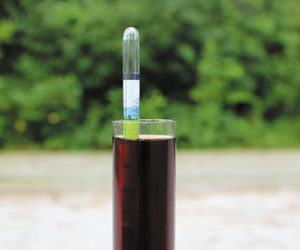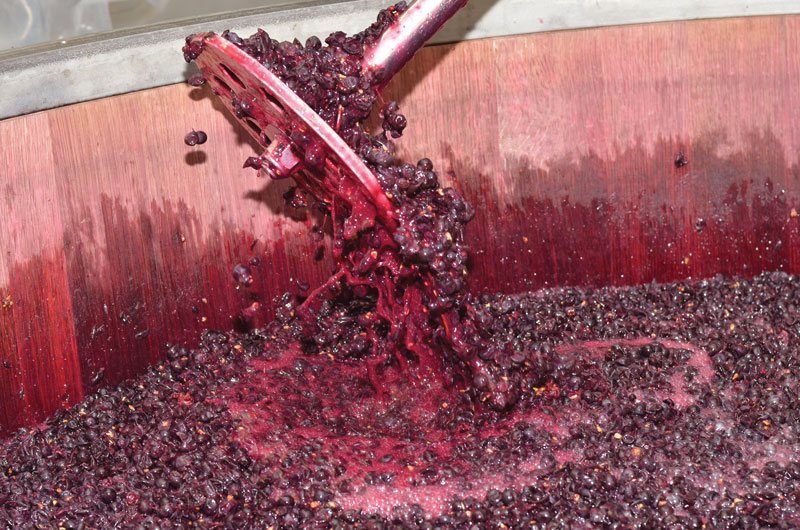What could vacuums have to do with wine kits? While there have been times when a wet/dry vacuum would have been very helpful in my wine cellar, there is a specific benefit a bit of vacuum can have for kit winemakers.
Regular readers will recall my article “Degassing Your Kit Wines,” in the October-November 2005 issue of WineMaker, which was an examination of the problems associated with dissolved carbon dioxide gas (CO2) in wine.
In commercial wineries, it usually takes a year or more to get wine ready for bottling, giving the CO2 gas plenty of time to come out of solution. In kit wines, however, the wine is intended to be bottled after a few months. In that article, the gas problem was addressed extensively in a discussion of properly enthusiastic stirring techniques, including the use of drill-mounted whips to drive off the maximum amount of gas. However, there are some folks who don’t have as much success with stirring as a kit manufacturer might hope. If you are one of the people having problems chasing the last of the bubbles out of your batch, there is another path you can take: vacuum degassing.
A perfect vacuum is a space that contains no matter. From a practical standpoint, any space in which the pressure is significantly lower than the pressure of the surrounding space can be called a vacuum.
Warning: Applying a vacuum, even a moderate one, to a vessel not designed to be pressure-resistant carries an inherent danger. Malleable vessels (thin steel or plastic) may deform or collapse. Rigid but brittle vessels (i.e. glass) need internal support, or they may catastrophically implode. Never apply a vacuum to an empty carboy. If there is any doubt about the strength or integrity of a vessel, do not apply a pressure differential to it. In addition, you must wear proper safety equipment, including eye protection at all times when applying a vacuum to any sealed vessel.
Time and Temperature
Ideally vacuum degassing should be done at the fining and stabilizing stage of your kit wine process, usually fifteen to twenty days after the onset of fermentation. Dissolved CO2 interferes with the action of fining agents. So, getting it out of solution before the finings are added will help them clear the wine effectively.
In addition to degassing at the right time, you need to degas at the right temperature. Colder wine will retain more gas, and more tenaciously. Ideally, your wine should be around 75 °F (24 °C). If you degas any cooler than 65 °F (18 °C) you’ll have a more difficult time getting the gas to break out of solution.
Fill ‘er up!
When degassing, it’s important to have a very nearly full carboy. When full, the carboy walls are supported by the wine inside. Wine isn’t easily compressible or expandable, and doesn’t change size in a vacuum, so it will help keep the sides of the carboy from flexing under negative pressure. Only apply a vacuum to a carboy that is topped up into the shoulder, past the straight-sided walls. The shoulder area of the carboy has a significantly thicker layer of glass than the sides, and is much less likely to suffer a catastrophic failure, even under a strong vacuum.
Electrolux, Mr. Goodwrench, Wine-Saver, or Mortuary: Generating Vacuum
Despite its name, the home vacuum cleaner doesn’t generate an efficient vacuum. At best it creates a localized vortex of slightly lowered air pressure that causes air to rush into the confines of its hose and bagging system, dragging along dirt and debris with it. Applied to a carboy, the intake hose of your vacuum wouldn’t produce a low enough pressure drop to pull any gas out of solution.
In order to generate a strong enough vacuum, you will need to use a mechanical vacuum pump. These range from the very simple hand pump and one-way valve to the complex (and expensive) electric vacuum pump. Each has its merits — and price point.
Easiest, simplest, fastest and almost certainly cheapest is the Wine-Saver vacuum units. You’ve probably seen these in magazines, if you don’t own one already. They consist of a stopper with a one-way valve that fits into the neck of a bottle, and a small pump-unit that slips on to the top of the stopper. When you have a partially empty bottle of wine, you slip the stopper in, attach the pump unit, and yanking away like you’re using a bicycle pump you evacuate part of the air from the bottle. The theory is that this will help an unfinished bottle of wine stay fresh for several days. (As I always say, if I ever have an unfinished bottle of wine, I intend to try this out.)
Some of the Wine-Saver units come with a one-way stopper that actually fits into the neck of a standard 6-gallon (23 -L) carboy without modification or adaptation, and almost all of them are priced well under $20 for a pump unit and a couple of stoppers.
If your model isn’t the kind that connects directly to the carboy, there are several ways to gin up a connection that will be vacuum-tight enough for our purposes. The simplest is probably to adapt a #6.5 bung, the size that fits into the neck of almost all glass carboys. Don’t use a #6 as it’s just small enough to get sucked into the carboy under pressure.
You’ll need to enlarge the hole in the middle of the bung to accept a short sleeve of rigid acrylic tubing, which will in turn fit snugly inside the one-way valve of the vacuum unit. Bungs are commonly made out of natural gum rubber, which is a fabulous material for our purposes, but with one drawback: it’s nearly impossible to drill a hole in it under normal circumstances. The rubber is so soft that it doesn’t want to cut under the drill bit.
The solution to this is to freeze the bung for an hour or so before applying the drill to it, making sure to work quickly before it heats up. Frozen natural rubber is not only more easily cut, it’s more rigid and deforms less under pressure. Of course, drilling a small, slippery object is a sure-fire way to unplanned body-piercing, so be sure to use a vice to hold the bung solidly in place while drilling. Drill presses with pre-jigged vice mounts are ideal for this purpose.
If you don’t have a vice, or a drill-press, don’t panic: before you freeze your bung, glue it to a small, flat piece of scrap wood, wide-end down. My personal favorite glue for all purposes is foaming, water-activated polyethylene glue, commonly sold under the Gorilla Glue brand. It glues dang near anything to anything and is low on fumes and toxicity. (One word of warning though: please, please keep this stuff out of the reach of pets. It has a slightly sweet taste that might entice some animals to eat it. When they do it expands in their digestive system with disastrous, life-threatening results.) A little goes a long way, and be sure to clean it up afterwards. Once the glue has set well (24 hours) pop the board and bung into the freezer, let it set, haul it out, clamp it to a work surface, and you’re ready to go.
Using a good, sharp drill bit, drill a half-inch hole though the middle of the bung. Don’t worry if it’s off-center, or winds up a bit eccentric or oval-shaped. Remember, gum rubber is malleable, and close enough is good for our purposes. If your bung was glued to a board, pry it off with a paint scraper or a chisel and use a razor knife to cut off the gluey surface —we don’t want that contacting our wine. Don’t worry if it isn’t pretty — it’s going to be wonderfully functional.
Now, cut off a short piece of 1/2 inch acrylic tubing (commonly available in hardware, plumbing or hobby stores, and obtainable from places that sell plastic rods and sheets). Two inches (5.1 cm) is plenty. You can cut this by scoring the tubing with a razor knife and snapping it off, or by cutting with a hacksaw, but my favorite is a standard plumbing pipe-cutter, which looks like a little “C” clamp with a sharp cutting wheel on one end of the clamp. Put it on the tube, tighten it snugly, spin it around and voilà — French for “hey, it worked!” — the tubing will snap off clean and neat.
Take the section of tubing and carefully force it into your newly drilled bung-hole. This will take a bit of doing, and should fit very snugly. At this point, you’re ready to degas!
Fit the end of the acrylic tube sticking out of the top of the bung into the bottom of the one-way valve, ensuring that it fits securely. Sanitize the bung, fit it into the neck of the carboy, attach the pump unit and start stroking away. You should see nothing at first, and then a few bubbles on the surface, eventually followed by a general evolution of gas throughout the carboy. If the wine is exceptionally saturated with gas, the foaming might come up near the neck of the carboy. If this happens, don’t panic — just release the stopper for a moment, allow the foam to subside and pump it again.
After a few minutes, you might notice a slowdown in the rise of bubbles through the wine. At this point, without releasing the vacuum, you can very gently and very carefully agitate the carboy. The best way to do this is to tilt it up on edge and gently slosh it back and forth. Under vacuum, this agitation will help force any stubborn gas out of solution. Pump some more, and see if the foaming continues.
Three to four series of pumping and agitating should be sufficient to completely de-gas your wine, and you can proceed on to the next steps.
Putting on the Brakes
Another interesting way to apply a vacuum to the carboy is through the use of an automotive brake-bleeding tool. These are used in repair shops to remove every last drop of fluid from hydraulic braking systems. They look a bit like a largish pair of shears with a hose barb coming out of them. When squeezed together, the scissor action of the unit works a piston pump, producing a fairly strong vacuum. While not usually as cheap as a vacuum wine saver unit, they are still relatively cheap.
To adapt this to your carboy, have a look at the hose barb coming off the unit. It will fit to either a 1/8 inch or 1/4 inch hose, which may or may not come with the unit. If the fitting is set for smaller than 1?4 inch, you may need to adapt it to the larger hose size by gluing it onto a piece of 1?4 inch hose.
When the unit is ready, sanitize the bung, fit it into the neck of the carboy, and squeeze, squeeze, squeeze the handles, following the routine described for the vacuum saver unit to get rid of all the gas. Because it develops a more robust vacuum, this system will get more gas out, more quickly than the vacuum saver.
Go Big or Go Mortician
The ultimate luxury ride for vacuum degassing is an electric vacuum pump. Costing over $200 a piece, these units are sturdy, fast and powerful, running off 110V wall current. In only moments, they develop vacuum as high as 29 inches of mercury. Pre-fitted with 1/4 inch hose barbs, they can be ordered through scientific supply catalogues, from the internet or through a local school/college laboratory. Or, you might get one used . . .
My own vacuum pump is a vintage model, built in the 1930’s by a company called Gomco. It’s a beautiful unit, of crackle-finished lacquered iron and stainless steel, with hand-blown glass vacuum reservoir, leather seals and the weight of an anvil, a real piece of vintage Art-Deco engineering and design. I got it for free when a friend of mine, a mortician, bought himself a new unit. You see, it is intended as a canular evacuation pump, for pulling the body fluids out of corpses. But don’t worry; I rinsed it out before I started using it.
There are a couple of points to keep in mind with electric vacuum pumps. First, wine and electricity don’t mix, so you’ll need to be careful to isolate the unit from contact with liquid, or even significant amounts of wine vapor. To do this, you’ll need a vacuum reservoir. This is simply another sealed vessel used as an intermediate unit between the pump and the carboy. If your pump comes with one, you’re golden. If it doesn’t, they’re not too difficult to make.
You’ll need to use a small, extremely sturdy glass or metal vessel as a reservoir. Just about the all-around best container for this purpose is a one-gallon glass jug in good condition. Large enough for liquid spill-over, but small enough to be fairly robust against vacuum pressure, most of them also accept a #6 or #6.5 bung. The key to adapting it is a double-drilled bung. The first hole accepts the hose from the vacuum pump. The second hole gets fitted to another hose, which goes into a single-hole bung that fits into the degassing carboy.
The hose running from the degassing carboy to the vacuum reservoir should be pulled right through the hole, until it nearly rests on the bottom of the gallon jug — when it’s all set up, you can see why: flip the switch and the vacuum pump begins removing air from the gallon jug. Naturally, atmosphere from the degassing carboy races through the hose to the area of lower pressure. As the lowered pressure increases in both vessels you’ll see the evolution of gas out of the wine. This will happen very quickly, and often with a lot of foaming and rising wine. If some liquid does get sucked from the degassing carboy it will flow through the hose to the bottom of the reservoir, well away from second hose leading to the vacuum pump, preventing you from ruining a $200 investment by trying to electrocute your wine.
Some units, such as my vintage Gomco, have vacuum adjustment valves, allowing you to dial-in the amount of vacuum you want. Others simply keep pumping until they hit their maximum limit. Usually hitting 29 inches of mercury isn’t going to crack a nearly-filled carboy in good condition, but you may wish to dial it back.
You can leave the vacuum on for a few minutes, but most of the action will be over in less than 30 seconds after achieving a good pressure differential: it’s really quite impressive, foaming, bubbling, rushing and gushing and then, poof! It all settles quietly, with no further activity. Now that’s good degassing! You can proceed with the rest of your winemaking steps with nary a bubble or a fizz.
Whither Goest the Gas?
A couple of points for the curious: while hard vacuums have some interesting properties, you needn’t worry about most of them when using your home degassing unit. I’m speaking of the fractional volatilization of different substances in the wine. Theoretically, a hard enough vacuum will cause the liquid inside the carboy to boil — even at room temperature. To understand this, think about the instructions for cooking at high altitudes: they sometimes say things along the lines of “boil for an extra ten minutes for every 1,000 feet above sea-level.” This is because under lowered pressure water boils at a lower temperature. The opposite is true as well, of course. Inside pressure cookers things get hot, fast, as water boils at much higher temperatures.
So, will your wine boil? Nope. The vacuum you’ll be able to develop won’t actually be strong enough to boil water at room temperature. But what about alcohol? Alcohol already boils off at a much lower temperature than water, and most people have heard of vacuum stills. Can you de-alcoholize your wine under vacuum? Again, nope — or at least nope in terms that you can measure. While you may lose a few alcohol molecules to the vacuum process, it won’t be enough to affect the actual percentage of alcohol in your wine. Finally, what about sulfite? It can be pulled out of solution by the action of vacuum. In this case, the answer is actually “yep, but.” You can lose one or two parts per million (ppm) of free SO2 to a strong vacuum over a period of hours. However, a couple of parts per million are beneath the ability of most home tests to measure, and not enough to warrant the addition of any extra sulfite to your kit wine.
That’s pretty much all there is to it: if you want a fast, very effective, and permanent solution to your degassing worries — and you aren’t afraid of a little work adapting some non-traditional gear to your home winemaking tools, or perhaps spending a bit of cash on a cool commercial vacuum pump — you can be the first on your block to give up vigorous stirring for languid repose, saving the strength in your arms for hoisting a sample of your latest batch!







